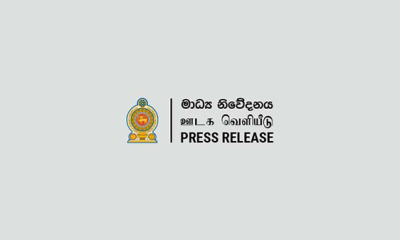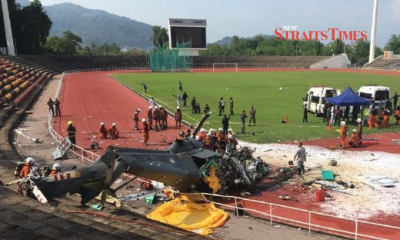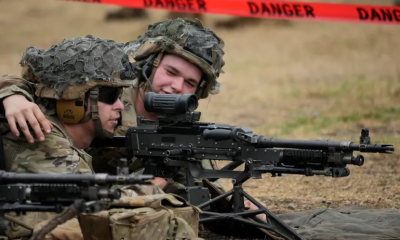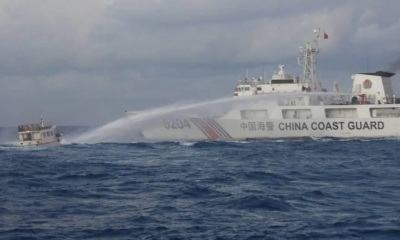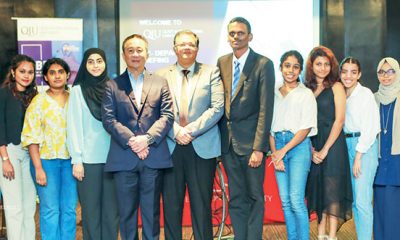Features
Biggest mysteries in Aviation history

By Dr Upul Wijayawardhana
Humans, for generations, would have been envious of birds as the freedom of the skies was entirely theirs. Born with abilities of terrestrial pursuits, humans soon took to water and mastered the art of transport in water too but attempts at flying like birds were in vain, most ending in disaster! However, myths abound. Daedalus, the engineer and his son, Icarus, are supposed to have flown with wings of wax and feather, according to Greek legend.
Though Daedalus flew successfully from Crete to Naples, overambitious Icarus, who flew too high got close to the Sun and fell to his death in the ocean due to wax wings melting. Persian King Kaj Kaoos is supposed to have flown around his kingdom with eagles attached to his throne and Alexander the Great is supposed to have done the same in a basket powered by four Griffins. If Valmiki’s Ramayana is to be believed, as many Indians do, our King Ravana ought to be considered the pioneer aviator!
Perhaps, the discovery of kites by the Chinese around 400BCE was the first inspiration for contraptions for flying as it was the forerunner for gliders and balloons. Leonardo da Vinci was the first to make a scientific study on flights in 1480’s and had left over 400 drawings to illustrate his theories of flight. The brothers, Joseph and Jacques Montgolfier were the inventors of the hot air balloon and their first manned flight was in November 1783.
English engineer, Sir George Cayley is sometimes referred to as “the father of aviation” as he designed the first successful human glider and discovered the four aerodynamic forces of flight, basic for designing aeroplanes. Sir George Cayley’s work in the early 19th Century was followed by the German engineer Otto Lilienthal’s work which influenced the Wright brothers, Wilbur and Orville making aviation history on 17th December 1903 when they flew their heavier-than-air “Wright Flyer” from Kitty Hawk, North Carolina, which travelled 120 feet in 12 seconds. That was the beginning of the revolution that produced supersonic aircraft like the Concord, giants like Boeing 747 and Airbus 380 and aircraft that can fly huge distances non-stop; from London to Perth and Singapore to New York. Quantas is planning to introduce a flight from Sydney to London next year, which covers 10,573 miles in 20 hours!
Until the mysterious disappearance of Malaysian airline’s flight MH370 ten years ago, the biggest mystery of all time in aviation history was that of pioneer aviatrix Amelia Erhart. She held many records, the most important being the first female aviator to fly solo across the Atlantic which she did in 1932. She took off from Newfoundland intending to fly to Paris but was forced to land in a pasture close to Derry in Northern Ireland due to bad weather and technical problems. Five years later she attempted to be the first female to circumnavigate the globe but disappeared over the central Pacific Ocean, near Howland Island, with her navigator Fred Noonan on 2nd July 1937, just three weeks prior to her fortieth birthday.
Although the most plausible explanation for her disappearance is exhausting fuel and crashing on to the ocean in the attempt to find Howland Island, which failed due to bad weather and primitive navigational tools available at the time, many theories have been postulated including that she and her navigator were captured by the Japanese. Perhaps, the number of books written on the subject equals that of her records! However, the mystery may be solved, at last, as Deep Sea Vision, an ocean exploration company, has reported locating a wreck in the Pacific, close to Howland Island, which may be the Lockheed 10-E Electra of Amelia Erhart. If it is confirmed, conspiracy theories would be proved wrong, more than anything else.
British aviatrix, Amy Johnson, the first woman to fly solo from London to Australia in 1930, held many records and was a celebrity of the time, just like her counterpart across the pond Amelia Erhart. During the Second World War, she volunteered to serve in the Air Transport Auxiliary which transported aircraft from factories to RAF bases. On 5th January 1941, while flying an Airspeed Oxford from Prestwick in Scotland to an RAF base in Oxford, she had gone off-course due to adverse weather conditions.
As the aircraft had run out of fuel and was crashing into the Thames Estuary near Herne Bay in Kent, she had bailed out of the aircraft. In spite of an extensive search, she could not be rescued and her body too was never found. There are speculations that she was a victim of ‘friendly-fire’ and also that her body may have been sucked up by the engine of the ship that went to rescue her. What tragic ends to two pioneering women on either side of the Atlantic!
The biggest mystery of all time is the disappearance of Malaysian airlines flight MH370 which is very much fresh in our memories although it happened ten years ago. In the early hours of Saturday 8th March 2014, 00.41 Malaysian time, the Boeing 777 aircraft with 227 passengers and 12 crew took off from Kuala Lumpur International Airport for the six-hour flight to Beijing.
At 01.19 the last message from the cockpit was “Good night, Malaysian three seven zero” which was in response to Malaysian air traffic control message that as the flight was leaving Malaysian airspace, it should contact Vietnamese air traffic control. Soon after this all communication was lost and the response from Malaysian airlines officials left much to be desired. The next morning a search began in the South China sea with no sightings.
It was later revealed that Malaysian military radar showed that the plane had almost made a U-turn raising the possibility that the pilots may have wanted to return to KL airport due to technical problems. However, after flying towards KL it turned left, heading West. Perhaps, this anomaly should have triggered a response from the Malaysian Airforce, as an aircraft deviating from the flightpath could pose a security threat. With this data, the search shifted to the West of Malaysia.
A week later, Inmarsat, the British Satellite communications company released data based on the pings from the Rolls-Royce engines of the aircraft, which suggested that MH370 had flown for 6 hours and the most likely site of the crash is in the Indian ocean, southwest of Australia. In spite of an extensive search covering three million square miles at tremendous cost the wreckage is still to be found.
As predicted by Prof Charitha Pattiaratchi, Professor of Coastal Oceanography of University of Western Australia, based on the studies of ocean currents and the presumed crash site, the first piece of debris of the aircraft was found in the French Reunion Island in July 2015. Subsequently, small pieces of the B777 have been found along the coasts of Mozambique, Madagascar and Tanzania confirming that MH370 crashed off the west coast of Australia. This brings into doubt the sighting by fisherman in southern Maldives of a large aircraft flying low which led to the conspiracy theory that it was hijacked to be taken to Diego Garcia but was downed by US Airforce. If this was the case, debris would have been found very much earlier along the western coastline of the Indian Ocean.
A new claim had been made, based on analysis of WSPR data, distortions of weak-signal radio communications between amateur radio operators, that the crash site is just south of the searched area and Liverpool University is addressing this issue. It seems very likely that the Malaysian government would authorise another search by Ocean Infinity, using a fleet of autonomous underwater vehicles with greater resolution than those used in the previous search.
Prof Pattiaratchi commented in a TV documentary that MH370 would ultimately be found, adding that it took 100 years to locate the wreck of the Titanic in spite of knowing exactly where it sank! “MH370 disappearance 10 years on: can we still find it?” a very informative article by Prof Pattiaratchi appears in ‘The Conversation’ website: (https://theconversation.com/mh370-disappearance-10-years-on-can-we-still-find-it-224954)
Worryingly, most experts seem to suggest that this was a wilful act by either the pilot or the co-pilot though no clear motive seems to emerge as to why either of them would do so. If it was murder-suicide, would a pilot fly an aircraft for hours, till the fuel supply is exhausted? Surely, even the angriest person would calm down after a time. Further, if it was done to make a point an attempt would be made to demonstrate this. I find it difficult to comprehend that a pilot would do this simply because he can do so, which is the only other explanation left!
Ten million passengers take to air each day and air travel has become the safest mode of transport but some recent incidents involving Boeing have made dents in public confidence as some are accusing Boeing of putting profits before safety. Hope it is not true!
Features
The heart-friendly health minister

by Dr Gotabhya Ranasinghe
Senior Consultant Cardiologist
National Hospital Sri Lanka
When we sought a meeting with Hon Dr. Ramesh Pathirana, Minister of Health, he graciously cleared his busy schedule to accommodate us. Renowned for his attentive listening and deep understanding, Minister Pathirana is dedicated to advancing the health sector. His openness and transparency exemplify the qualities of an exemplary politician and minister.
Dr. Palitha Mahipala, the current Health Secretary, demonstrates both commendable enthusiasm and unwavering support. This combination of attributes makes him a highly compatible colleague for the esteemed Minister of Health.
Our discussion centered on a project that has been in the works for the past 30 years, one that no other minister had managed to advance.
Minister Pathirana, however, recognized the project’s significance and its potential to revolutionize care for heart patients.
The project involves the construction of a state-of-the-art facility at the premises of the National Hospital Colombo. The project’s location within the premises of the National Hospital underscores its importance and relevance to the healthcare infrastructure of the nation.
This facility will include a cardiology building and a tertiary care center, equipped with the latest technology to handle and treat all types of heart-related conditions and surgeries.
Securing funding was a major milestone for this initiative. Minister Pathirana successfully obtained approval for a $40 billion loan from the Asian Development Bank. With the funding in place, the foundation stone is scheduled to be laid in September this year, and construction will begin in January 2025.
This project guarantees a consistent and uninterrupted supply of stents and related medications for heart patients. As a result, patients will have timely access to essential medical supplies during their treatment and recovery. By securing these critical resources, the project aims to enhance patient outcomes, minimize treatment delays, and maintain the highest standards of cardiac care.
Upon its fruition, this monumental building will serve as a beacon of hope and healing, symbolizing the unwavering dedication to improving patient outcomes and fostering a healthier society.We anticipate a future marked by significant progress and positive outcomes in Sri Lanka’s cardiovascular treatment landscape within the foreseeable timeframe.
Features
A LOVING TRIBUTE TO JESUIT FR. ALOYSIUS PIERIS ON HIS 90th BIRTHDAY

by Fr. Emmanuel Fernando, OMI
Jesuit Fr. Aloysius Pieris (affectionately called Fr. Aloy) celebrated his 90th birthday on April 9, 2024 and I, as the editor of our Oblate Journal, THE MISSIONARY OBLATE had gone to press by that time. Immediately I decided to publish an article, appreciating the untiring selfless services he continues to offer for inter-Faith dialogue, the renewal of the Catholic Church, his concern for the poor and the suffering Sri Lankan masses and to me, the present writer.
It was in 1988, when I was appointed Director of the Oblate Scholastics at Ampitiya by the then Oblate Provincial Fr. Anselm Silva, that I came to know Fr. Aloy more closely. Knowing well his expertise in matters spiritual, theological, Indological and pastoral, and with the collaborative spirit of my companion-formators, our Oblate Scholastics were sent to Tulana, the Research and Encounter Centre, Kelaniya, of which he is the Founder-Director, for ‘exposure-programmes’ on matters spiritual, biblical, theological and pastoral. Some of these dimensions according to my view and that of my companion-formators, were not available at the National Seminary, Ampitiya.
Ever since that time, our Oblate formators/ accompaniers at the Oblate Scholasticate, Ampitiya , have continued to send our Oblate Scholastics to Tulana Centre for deepening their insights and convictions regarding matters needed to serve the people in today’s context. Fr. Aloy also had tried very enthusiastically with the Oblate team headed by Frs. Oswald Firth and Clement Waidyasekara to begin a Theologate, directed by the Religious Congregations in Sri Lanka, for the contextual formation/ accompaniment of their members. It should very well be a desired goal of the Leaders / Provincials of the Religious Congregations.
Besides being a formator/accompanier at the Oblate Scholasticate, I was entrusted also with the task of editing and publishing our Oblate journal, ‘The Missionary Oblate’. To maintain the quality of the journal I continue to depend on Fr. Aloy for his thought-provoking and stimulating articles on Biblical Spirituality, Biblical Theology and Ecclesiology. I am very grateful to him for his generous assistance. Of late, his writings on renewal of the Church, initiated by Pope St. John XX111 and continued by Pope Francis through the Synodal path, published in our Oblate journal, enable our readers to focus their attention also on the needed renewal in the Catholic Church in Sri Lanka. Fr. Aloy appreciated very much the Synodal path adopted by the Jesuit Pope Francis for the renewal of the Church, rooted very much on prayerful discernment. In my Religious and presbyteral life, Fr.Aloy continues to be my spiritual animator / guide and ongoing formator / acccompanier.
Fr. Aloysius Pieris, BA Hons (Lond), LPh (SHC, India), STL (PFT, Naples), PhD (SLU/VC), ThD (Tilburg), D.Ltt (KU), has been one of the eminent Asian theologians well recognized internationally and one who has lectured and held visiting chairs in many universities both in the West and in the East. Many members of Religious Congregations from Asian countries have benefited from his lectures and guidance in the East Asian Pastoral Institute (EAPI) in Manila, Philippines. He had been a Theologian consulted by the Federation of Asian Bishops’ Conferences for many years. During his professorship at the Gregorian University in Rome, he was called to be a member of a special group of advisers on other religions consulted by Pope Paul VI.
Fr. Aloy is the author of more than 30 books and well over 500 Research Papers. Some of his books and articles have been translated and published in several countries. Among those books, one can find the following: 1) The Genesis of an Asian Theology of Liberation (An Autobiographical Excursus on the Art of Theologising in Asia, 2) An Asian Theology of Liberation, 3) Providential Timeliness of Vatican 11 (a long-overdue halt to a scandalous millennium, 4) Give Vatican 11 a chance, 5) Leadership in the Church, 6) Relishing our faith in working for justice (Themes for study and discussion), 7) A Message meant mainly, not exclusively for Jesuits (Background information necessary for helping Francis renew the Church), 8) Lent in Lanka (Reflections and Resolutions, 9) Love meets wisdom (A Christian Experience of Buddhism, 10) Fire and Water 11) God’s Reign for God’s poor, 12) Our Unhiddden Agenda (How we Jesuits work, pray and form our men). He is also the Editor of two journals, Vagdevi, Journal of Religious Reflection and Dialogue, New Series.
Fr. Aloy has a BA in Pali and Sanskrit from the University of London and a Ph.D in Buddhist Philosophy from the University of Sri Lankan, Vidyodaya Campus. On Nov. 23, 2019, he was awarded the prestigious honorary Doctorate of Literature (D.Litt) by the Chancellor of the University of Kelaniya, the Most Venerable Welamitiyawe Dharmakirthi Sri Kusala Dhamma Thera.
Fr. Aloy continues to be a promoter of Gospel values and virtues. Justice as a constitutive dimension of love and social concern for the downtrodden masses are very much noted in his life and work. He had very much appreciated the commitment of the late Fr. Joseph (Joe) Fernando, the National Director of the Social and Economic Centre (SEDEC) for the poor.
In Sri Lanka, a few religious Congregations – the Good Shepherd Sisters, the Christian Brothers, the Marist Brothers and the Oblates – have invited him to animate their members especially during their Provincial Congresses, Chapters and International Conferences. The mainline Christian Churches also have sought his advice and followed his seminars. I, for one, regret very much, that the Sri Lankan authorities of the Catholic Church –today’s Hierarchy—- have not sought Fr.
Aloy’s expertise for the renewal of the Catholic Church in Sri Lanka and thus have not benefited from the immense store of wisdom and insight that he can offer to our local Church while the Sri Lankan bishops who governed the Catholic church in the immediate aftermath of the Second Vatican Council (Edmund Fernando OMI, Anthony de Saram, Leo Nanayakkara OSB, Frank Marcus Fernando, Paul Perera,) visited him and consulted him on many matters. Among the Tamil Bishops, Bishop Rayappu Joseph was keeping close contact with him and Bishop J. Deogupillai hosted him and his team visiting him after the horrible Black July massacre of Tamils.
Features
A fairy tale, success or debacle

Sri Lanka-Singapore Free Trade Agreement
By Gomi Senadhira
senadhiragomi@gmail.com
“You might tell fairy tales, but the progress of a country cannot be achieved through such narratives. A country cannot be developed by making false promises. The country moved backward because of the electoral promises made by political parties throughout time. We have witnessed that the ultimate result of this is the country becoming bankrupt. Unfortunately, many segments of the population have not come to realize this yet.” – President Ranil Wickremesinghe, 2024 Budget speech
Any Sri Lankan would agree with the above words of President Wickremesinghe on the false promises our politicians and officials make and the fairy tales they narrate which bankrupted this country. So, to understand this, let’s look at one such fairy tale with lots of false promises; Ranil Wickremesinghe’s greatest achievement in the area of international trade and investment promotion during the Yahapalana period, Sri Lanka-Singapore Free Trade Agreement (SLSFTA).
It is appropriate and timely to do it now as Finance Minister Wickremesinghe has just presented to parliament a bill on the National Policy on Economic Transformation which includes the establishment of an Office for International Trade and the Sri Lanka Institute of Economics and International Trade.
Was SLSFTA a “Cleverly negotiated Free Trade Agreement” as stated by the (former) Minister of Development Strategies and International Trade Malik Samarawickrama during the Parliamentary Debate on the SLSFTA in July 2018, or a colossal blunder covered up with lies, false promises, and fairy tales? After SLSFTA was signed there were a number of fairy tales published on this agreement by the Ministry of Development Strategies and International, Institute of Policy Studies, and others.
However, for this article, I would like to limit my comments to the speech by Minister Samarawickrama during the Parliamentary Debate, and the two most important areas in the agreement which were covered up with lies, fairy tales, and false promises, namely: revenue loss for Sri Lanka and Investment from Singapore. On the other important area, “Waste products dumping” I do not want to comment here as I have written extensively on the issue.
1. The revenue loss
During the Parliamentary Debate in July 2018, Minister Samarawickrama stated “…. let me reiterate that this FTA with Singapore has been very cleverly negotiated by us…. The liberalisation programme under this FTA has been carefully designed to have the least impact on domestic industry and revenue collection. We have included all revenue sensitive items in the negative list of items which will not be subject to removal of tariff. Therefore, 97.8% revenue from Customs duty is protected. Our tariff liberalisation will take place over a period of 12-15 years! In fact, the revenue earned through tariffs on goods imported from Singapore last year was Rs. 35 billion.
The revenue loss for over the next 15 years due to the FTA is only Rs. 733 million– which when annualised, on average, is just Rs. 51 million. That is just 0.14% per year! So anyone who claims the Singapore FTA causes revenue loss to the Government cannot do basic arithmetic! Mr. Speaker, in conclusion, I call on my fellow members of this House – don’t mislead the public with baseless criticism that is not grounded in facts. Don’t look at petty politics and use these issues for your own political survival.”
I was surprised to read the minister’s speech because an article published in January 2018 in “The Straits Times“, based on information released by the Singaporean Negotiators stated, “…. With the FTA, tariff savings for Singapore exports are estimated to hit $10 million annually“.
As the annual tariff savings (that is the revenue loss for Sri Lanka) calculated by the Singaporean Negotiators, Singaporean $ 10 million (Sri Lankan rupees 1,200 million in 2018) was way above the rupees’ 733 million revenue loss for 15 years estimated by the Sri Lankan negotiators, it was clear to any observer that one of the parties to the agreement had not done the basic arithmetic!
Six years later, according to a report published by “The Morning” newspaper, speaking at the Committee on Public Finance (COPF) on 7th May 2024, Mr Samarawickrama’s chief trade negotiator K.J. Weerasinghehad had admitted “…. that forecasted revenue loss for the Government of Sri Lanka through the Singapore FTA is Rs. 450 million in 2023 and Rs. 1.3 billion in 2024.”
If these numbers are correct, as tariff liberalisation under the SLSFTA has just started, we will pass Rs 2 billion very soon. Then, the question is how Sri Lanka’s trade negotiators made such a colossal blunder. Didn’t they do their basic arithmetic? If they didn’t know how to do basic arithmetic they should have at least done their basic readings. For example, the headline of the article published in The Straits Times in January 2018 was “Singapore, Sri Lanka sign FTA, annual savings of $10m expected”.
Anyway, as Sri Lanka’s chief negotiator reiterated at the COPF meeting that “…. since 99% of the tariffs in Singapore have zero rates of duty, Sri Lanka has agreed on 80% tariff liberalisation over a period of 15 years while expecting Singapore investments to address the imbalance in trade,” let’s turn towards investment.
Investment from Singapore
In July 2018, speaking during the Parliamentary Debate on the FTA this is what Minister Malik Samarawickrama stated on investment from Singapore, “Already, thanks to this FTA, in just the past two-and-a-half months since the agreement came into effect we have received a proposal from Singapore for investment amounting to $ 14.8 billion in an oil refinery for export of petroleum products. In addition, we have proposals for a steel manufacturing plant for exports ($ 1 billion investment), flour milling plant ($ 50 million), sugar refinery ($ 200 million). This adds up to more than $ 16.05 billion in the pipeline on these projects alone.
And all of these projects will create thousands of more jobs for our people. In principle approval has already been granted by the BOI and the investors are awaiting the release of land the environmental approvals to commence the project.
I request the Opposition and those with vested interests to change their narrow-minded thinking and join us to develop our country. We must always look at what is best for the whole community, not just the few who may oppose. We owe it to our people to courageously take decisions that will change their lives for the better.”
According to the media report I quoted earlier, speaking at the Committee on Public Finance (COPF) Chief Negotiator Weerasinghe has admitted that Sri Lanka was not happy with overall Singapore investments that have come in the past few years in return for the trade liberalisation under the Singapore-Sri Lanka Free Trade Agreement. He has added that between 2021 and 2023 the total investment from Singapore had been around $162 million!
What happened to those projects worth $16 billion negotiated, thanks to the SLSFTA, in just the two-and-a-half months after the agreement came into effect and approved by the BOI? I do not know about the steel manufacturing plant for exports ($ 1 billion investment), flour milling plant ($ 50 million) and sugar refinery ($ 200 million).
However, story of the multibillion-dollar investment in the Petroleum Refinery unfolded in a manner that would qualify it as the best fairy tale with false promises presented by our politicians and the officials, prior to 2019 elections.
Though many Sri Lankans got to know, through the media which repeatedly highlighted a plethora of issues surrounding the project and the questionable credentials of the Singaporean investor, the construction work on the Mirrijiwela Oil Refinery along with the cement factory began on the24th of March 2019 with a bang and Minister Ranil Wickremesinghe and his ministers along with the foreign and local dignitaries laid the foundation stones.
That was few months before the 2019 Presidential elections. Inaugurating the construction work Prime Minister Ranil Wickremesinghe said the projects will create thousands of job opportunities in the area and surrounding districts.
The oil refinery, which was to be built over 200 acres of land, with the capacity to refine 200,000 barrels of crude oil per day, was to generate US$7 billion of exports and create 1,500 direct and 3,000 indirect jobs. The construction of the refinery was to be completed in 44 months. Four years later, in August 2023 the Cabinet of Ministers approved the proposal presented by President Ranil Wickremesinghe to cancel the agreement with the investors of the refinery as the project has not been implemented! Can they explain to the country how much money was wasted to produce that fairy tale?
It is obvious that the President, ministers, and officials had made huge blunders and had deliberately misled the public and the parliament on the revenue loss and potential investment from SLSFTA with fairy tales and false promises.
As the president himself said, a country cannot be developed by making false promises or with fairy tales and these false promises and fairy tales had bankrupted the country. “Unfortunately, many segments of the population have not come to realize this yet”.
(The writer, a specialist and an activist on trade and development issues . )


